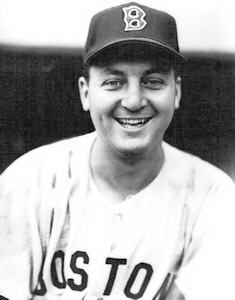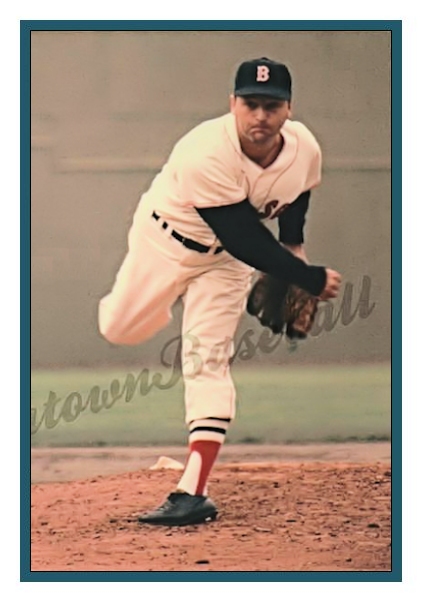|
“FENWAY'S BEST PLAYERS”  |
|||
A vital part of the Boston Red Sox teams of the 1950s and early 1960s, Ivan Martin “Ike” Delock, a gritty right-handed pitcher, was born, in Highland Park, Michigan. A Marine Corps veteran, he compiled an 84-75 record in a career which, with the exception of a one-month stint with the Baltimore Orioles in 1963, was spent entirely with the Red Sox. At 5-feet-11 inches and 175 pounds, Delock earned a reputation as a fierce competitor, despite playing for mediocre Red Sox teams. During his youth, Ike was a star athlete who graduated from Highland Park High School, playing baseball (third base), basketball (guard), and football (fullback). He also played in the Detroit Baseball Federation. While serving with the Marines from 1946 to 1948, he played with his camp teams at Great Lakes and Camp Lejeune at which time he began to learn how to pitch, mainly because there were no other pitchers on his team. His pitching prowess was established early on with the camp team, as he struck out 21 batters in his first start. Upon his departure from the service, Ike drew the attention of Red Sox scout Maurice DeLoof, who had come to the Delock household to sign Ike’s brother, Joe. Ike, who had been scouted by the New York Yankees, was asked by DeLoof how much the Yankees were offering him to sign. Ike told him, DeLoof offered more and both Ike and Joe signed with the Red Sox, without the scout having ever seen Ike on a baseball diamond. Delock was assigned to the Auburn (New York) Cayugas of the Border League (Class C). From there, he continued his baseball education and moved in 1949 to the Oneonta (New York) Red Sox of the Canadian-American League (Class C), managed by future Red Sox coach Eddie Popowski; in 1950 to the Roanoke (Virginia) Red Sox of the Piedmont League (Class B), and in 1951 to the Scranton (Pennsylvania) Red Sox of the Eastern League (Class A). 1 Ike won 12 games in 1949 and 15 games in 1950, but it was at Scranton that he began to show great promise as a potential major-league pitcher, winning 20 games and losing 4, with an excellent 1.92 earned-run average, netting him a promotion first to the Birmingham (Alabama) Barons of the Double-A Southern Association at the tail end of 1951. Projected as both a starting and relief pitcher, Ike broke spring training with the Red Sox in 1952 and appeared in his first major-league game on April 17th. Delock picked up his first win on the 24th, as the Red Sox beat the Yankees in an 11-inning game at Fenway Park. He worked the final inning and again gave up a pair of hits but escaped unscathed, striking out Mickey Mantle with the bases loaded and two outs. He pitched the final 2 1/3 innings against his home-town Detroit Tigers, allowing no hits, and was the pitcher of record when Ted Williams hit a game-winning homer in his final at-bat before being recalled for Korean War duty with the Marines. Ike lost games in relief on May 4th and May 13th. His first start, on June 10th, resulted in a loss, when he was driven out early by the St. Louis Browns in Boston, but the second time he was given a starting assignment, nine days later, he shut out the Browns in St. Louis with a 2-0 five-hitter. It was the first of his six career shutouts. He stayed with the team until August 7th and was optioned to Triple-A Louisville to make room for Ellis Kinder, who was returning from back problems. Ike’s demotion was brief. Ike returned in time to start the August 22nd game against the White Sox. In 39 games during the 1952 season, Delock worked mostly out of the bullpen. He started seven games and had five saves in 95 innings of work. The following spring, Delock was sent back to Louisville to start the season. He was recalled to Boston in July, appearing in 23 games. He had a 3-1 record, in 48 2/3 innings with an ERA of 4.44. Entering spring training of 1954, his career was at a crossroads. Always a control pitcher, and having abundant confidence in his abilities, he knew nonetheless that he was in competition for a spot on the Red Sox roster; and this caused him to focus more on what it took to become a major-league pitcher. Taking the advice of Red Sox coach Del Baker, he changed his stride, which helped improve his control. Despite his efforts, he was sent to Louisville, where he spent the entire 1954 season. Louisville skipper Mike Higgins convinced Ike that he had everything to gain by having a great season, since the Red Sox were out of options on him and he would have to be with the major-league club the next year or somewhere else. Using this as motivation, Delock not only had an effective season on the mound, but was a leader on a Colonels club that won the American Association championship and the Junior World Series over the Syracuse Chiefs of the International League. The championships also earned Higgins the manager’s job at Boston, and hastened Ike’s rise to the big club. In 1955, despite being idled by a sore shoulder for nearly a month, he split time as a starter and reliever for the Red Sox, winning nine games and losing seven, with a 3.76 ERA. His fine season helped keep the Red Sox in the pennant race into August. Entering the 1956 season, Ike was pegged as a starting pitcher, but before long, after being approached by Higgins, showed his prowess as a reliever and he posted a record of 11-2 in that role, leading the league in relief victories. His efforts earned him the Unsung Hero award presented by the Boston Baseball Writers after the 1956 season, and the Red Sox rewarded him with a contract. Back as a reliever in 1957, Ike seemingly made peace with his assignment to the bullpen. After a 9-8 record, mostly in relief, in 1957, he was returned to the starting rotation in June 1958, because previous starters for the Bosox were either hurt or ineffective. After beginning the year, Ike won his first six starts. He still pitched well enough to win 14 games in all, which earned him the "Pitcher of the Year" award given by the Boston Baseball Writers. With the successes of the three previous seasons bolstering his confidence, Delock, now 28 years old, seemed poised to benefit from his pitching experiences, both as a starter and from the bullpen, with a big season. In 1959 Ike came to spring training determined to add another pitch to his repertoire – a changeup slider. 9But when he struggled as a starter in the first half of the season, as a result of elbow and shoulder injuries, he was moved back to the bullpen. The injury to his elbow, continued into 1960 and he was sent to Johns Hopkins Hospital in Baltimore for an examination, which showed muscular soreness. The diagnosis was that rest and time were the best remedies. Despite the late start to his season, Ike managed to start 23 games, completing two of them, for a 9-10 record. In 1961, Ike reported to spring training determined to improve on his 1960 season, but in 28 starts, his record was 6-9 with a 4.90 ERA, with only three complete games. After being appointed the player representative for the Red Sox in the offseason, Ike started the 1962 season slowly, with five consecutive no-decisions, until he put together three straight wins, two of them complete games. However, on July 2nd, in a game against Minnesota, Delock tore ligaments in his right knee on a play while backing up home plate, causing him to spend 30 days on the disabled list. The combination of age (he was 33), injury, and ineffectiveness finally took its toll on Delock’s career in 1963, as he was released by the Red Sox on June 9th, after not seeing eye-to-eye with manager Johnny Pesky. For his career in major-league baseball, Ike ended up with an 84-75 won-lost record. Considering that the Red Sox frequently were below .500 and never were closer than 12 games behind the AL leaders at season’s end for his tenure in Boston, Ike’s career statistics, although not Hall of Fame worthy, were impressive enough to land him in the top 25 of all-time Red Sox pitchers. Ike Delock passed away in Raleigh, NC on February 28, 2022 at the age of 92.
|
|||

